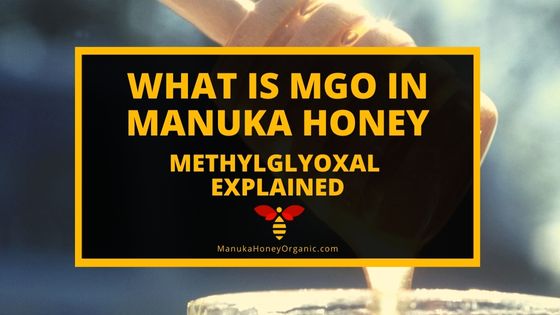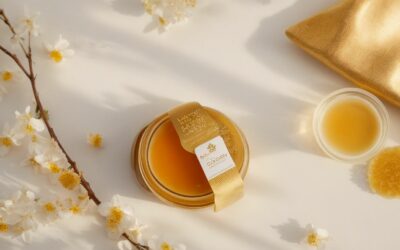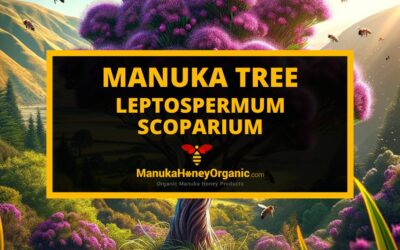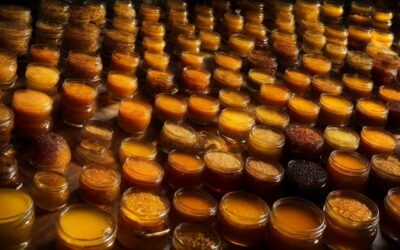Introduction To MGO in Manuka Honey
Manuka honey is a unique and highly sought-after honey produced by bees collecting nectar from the Manuka plant, which is native to New Zealand and parts of Australia.This special honey has various health benefits, with its unique healing, anti-bacterial and anti-microbial properties all coming down to its high concentration of a naturally occurring compound called methylglyoxal (MGO).
In this article, we aim to provide an in-depth exploration of MGO in Manuka honey and its influences on the honey’s potency, quality and health benefits.
What is MGO in Manuka Honey?
Methylglyoxal (MGO) is a naturally occurring compound found in high concentrations in Manuka honey. It has strong antibacterial and antioxidant properties, making it an ideal ingredient when producing Manuka honey.By understanding the role of MGO in this type of honey, we can gain a greater appreciation for its benefits as a health aid and dietary supplement.
Manuka honey is produced by bees that feed on the nectar of the manuka bush, which is native to New Zealand.A combination of factors gives Manuka honey its unique properties – namely, hydrogen peroxide and Leptosperin compounds are responsible for most of its anti-bacterial activity.Methylglyoxal makes up the other chief component, accounting for around 50% of its antibacterial potency.
The MGO in Manuka honey contributes to its nutritional value through its strong antioxidative capabilities, including:
- Scavenging free radicals that contribute to oxidative damage within our bodies
- Helping to prevent cancer development caused by environmental stressors like pollution and UV radiation
MGO also possesses anti-inflammatory properties which help reduce joint pain associated with arthritis or other physical ailments.Furthermore, it may also help reduce inflammation associated with chronic diseases like diabetes or Crohn’s disease because it works to control sugar levels as well as levels of bile acids within the body’s digestive system.Lastly, at clinically proven levels (defined 40 mg/kg +), MGO has been found to be effective at treating sore throats or mild intestinal infections caused by bacteria such as salmonella or E coli bacteria.
In short, Manuka honey offers many health benefits due largely to methylglyxal’s antibacterial properties and antioxidative capabilities which support healthy immune function and protect against environmental pollutants.
When chosen carefully using laboratory testing standards such as those provided by UMF® Certification Body programmes (Bioactive Supermark & NPA/MGS) consumers can have confidence they are getting a natural product with scientifically tested results – meaning they can rest assured that their chosen Manuka product indeed supplies an effective health aide activity.
What is the MGO Rating?
The MGO (Methylglyoxal) rating is a measure of the concentration of Methylglyoxal compound found in a Manuka honey. Methylglyoxal (MGO) is a naturally occurring chemical compound present in small quantities in all types of honey, including Manuka Honey.
It is responsible for the anti-bacterial and healing properties attributed to Manuka honey.
The higher the level of MGO found in a specific product, the “stronger” and more effective it is in treating ailments such as sore throats, mouth ulcers, acid reflux and skin infections.
The MGO rating on a jar of Manuka honey helps identify its strength and therapeutic benefits. The rating typically follows an ‘MGO’ prefix; for example ‘MGO 400+’ means that the product contains at least 400mg/kg of methylglyoxal.
Generally speaking, the higher the MGO concentration,the higher its health benefits – with some products containing as much as 800mg/kg or more!
When comparing products with similar ratings, you should also look out for other labeling information such as UHF activity or Active UMF factor which indicates additional therapeutic benefits.
What is the Unique Manuka Factor (UMF)?
The Unique Manuka Factor (UMF) is a licensed trademark rating system applied to some types of Manuka honey to indicate its non-peroxide antibacterial strength. The UMF rating system measures the three signature compounds found in the nectar of Manuka trees: DHA, MGO and Leptosperin.
DHA is a sugar molecule derived from dihydroxyacetone, which is present in all types of honey produced from flowering plants. DHA is not responsible for the antibacterial strength of Manuka honey, but it is an essential component for taste and texture.
Methylglyoxal (MGO) is a compound found in high levels in Manuka honey, which has been scientifically proven to have antibacterial properties.It is this compound that gives Manuka honey its unique antibacterial potency and makes it so effective at killing bacteria that cause food-borne illnesses and other infections.
Leptosperin is a bioactive protein complex that gives certain types of Manuka honey their healing properties, enhancing the antibacterial effects to make it even more potent against various types of bacteria.
The combination of these three signature compounds make up the UMF rating system because each one contributes to developing stronger antimicrobial activities within the honey by producing stronger hydrogen peroxide upon contact with bodily fluids or surfaces contaminated with microbes.The higher the concentration of these compounds, the more potent and effective it will be as antimicrobial agent and thus, have a higher UMF rating on its label from 5+ up to 16+.
Manuka Honey Production
Manuka honey is a monofloral honey produced from the nectar of the manuka tree, native to New Zealand.Manuka flowers are also known for their antifungal, anti-inflammatory and anti-bacterial properties, which make Manuka honey a very powerful and healing honey.
Manuka honey is produced by bees collecting nectar from the manuka tree and converting the nectar into honey.The production of Manuka honey involves careful management of beekeeping practices and harvesting techniques to ensure high-quality production.
Additionally, the concentration of methylglyoxal (MGO) in Manuka honey is tested in a laboratory and assigned a MGO rating to determine the honey’s potency and quality.Manuka Plant and Flowers
Manuka flowers have a unique combination of compounds which provides the nectar used to produce Manuka honey. The leaves and flowers of the manuka tree contain an oil found only in New Zealand and parts of Australia.This oil, called Manuka Oil, contains numerous volatile compounds with potent antimicrobial properties.
When the bees collect Manuka nectar, it naturally contains high levels of a compound called Methylglyoxal (MGO) which is the major antibacterial activity in Manuka honey.
This is what gives Manuka honey its unique healing properties.Methylglyoxal, or ‘MGO’, is produced naturally when the bees feed on Manuka flowers by converting dihydroxyacetone (DHA) which is found in high concentrations in manuka flower nectar.
The levels of MGO vary depending on what type of flowering phase the manuka trees are in, e.g. early or late phase.
However, research has shown that the highest concentration of Methylglyoxal will be found in honey produced during peak spring flowering season when manuaka trace amounts are at their strongest.
The higher percentage of Methylglyoxal leads to higher activity ratings for Manuka honey as these actives help identify its strength and purity compared to other types honeys available on the market today. As such, this valuable ingredient affects not just antimicrobial.
Manuka Nectar and Pollen
The ability of Manuka honey to produce powerful health benefits resides in the nectar from which it is produced. That nectar comes from the same small flower that produces Tea Tree oil (Leptospermum scoparium). The flowers are found largely in Australia and New Zealand.
When bees go to work on a Manuka bush, they collect two main sources of food – nectar and pollen. Nectar is the sweet liquid found inside a flower and is provided by special glands inside the flower head.Pollen is collected from developing male flowers when bees vibrate their wings in front of the stamen – part of a flowering plant’s male reproductive organ.
When bees consume both nectar and pollen, they convert them into bee jelly or bee bread that then saves as quickly digestible fuel for sociable bee activities.In this process, some of the components of Manuka honey – such as Methylglyoxal (MGO) are produced as well.MGO gives this unique honey its antibacterial properties; the higher amount of methylglyoxal present varies depending on potential variations such as Mānuka bush genetics, soil condition, climate conditions and seasonal availability when harvesting takes place.
To determine MGO rating each batch has specific tests conducted to test for levels of methylglyoxal (MgO). Generally speaking, level ratings start at 100+ which can reach up to 800+ or beyond depending on these factors mentioned above.
From Hive to Jar
Manuka honey is produced from the nectar of certain types of New Zealand flowers, primarily Leptospermum scoparium and Leptospermum polygalifolium.As bees gather nectar to produce honey, they inadvertently transport the special compounds that Manuka contains related to its healing properties.
Once collected, Manuka honey typically goes through two general steps before reaching store shelves. During the first step, commercial hives extract the honey’s nutritional content by pressing it through a fine filter and storing it in drums or buckets.After collection, large-scale producers pasteurize their Manuka in temperatures of up 180°F (82°C) or greater to extend shelf life and preserve flavor.
The second stage involves testing for unique markers found in Manuka honey that help distinguish its healing properties from other forms of traditional honey.The significance of Methylglyoxal (MGO) was discovered in 2008 when researchers found a definitive correlation between concentration levels above 100 mg/kg and enhanced antibacterial activity during laboratory testing.To be labeled authentic Manuka Honey, laboratories must detect concentrations between 100 – 900 mg/kg before issuing a certification indication its origin from New Zealand’s native Leptospermum flowers species.
Once certified for production quality, fermentation time influenced by heat should not exceed more than 4% over 12 months; this ensures freshness with measurable MGO levels remain intact even after long-term storage with an acceptable flavor profile. After passing rigorous tests designed to showcase MGO strength while retaining key nutritional content like vitamins including B1 (thiamin), B2 (riboflavin), C (ascorbic acid), calcium, iron phosphate and magnesium.Manufacturers use this information to display labels that advertise antioxidant counts and health benefits prominently on jar lids or packaging fronts so consumers can easily identify what makes one jar different than another when evaluating potential purchases.
High Concentration of Methylglyoxal
Manuka honey is a type of honey that is produced by bees that feed exclusively on the manuka tree, which is native to New Zealand and Australia. It has been used medicinally for centuries due to its high concentration of active compounds and purported health benefits.One of the most studied compounds in Manuka is called methylglyoxal (MGO).
Methylglyoxal, also known as MGO, is a compound found in high concentrations in Manuka honey. It acts as an antioxidant, helping to protect the body from free radical damage and other forms of oxidative stress.Studies have also shown that it can help reduce inflammation, regulate blood sugar levels, and promote wound healing.
In addition to its anti-inflammatory and protective properties, MGO has also been studied for its potential antimicrobial activity. It has been found to inhibit the growth of certain bacteria including Streptococcus mutans which can cause tooth decay.It may also play a role in preventing upper respiratory infections such as sinusitis and bronchitis by killing off microbial invaders before they have a chance to colonize the body’s airways or digestive tract.
The unique properties of Manuka honey are due largely to its high concentration of MGO which can range from 100-550 mg/kg. This makes it different than other types of honey because other kinds generally contain much lower levels or none at all. The higher concentration found in Manuka makes it more effective at providing medicinal benefits compared to other types of honey when used topically or ingested orally.
Buying Genuine Manuka Honey
Manuka honey is considered to be a superior natural remedy, because of its naturally occurring high levels of Methylglyoxal (MGO). Its antibacterial, anti-inflammatory and antimicrobial properties make it an ideal ingredient for treatments of various ailments.
When buying genuine Manuka honey, you need to understand which MGO ratings you should look out for so as to ensure you get the highest quality. Let’s explore what makes Manuka honey so special, and how you can make sure you get the real deal:
New Zealand Government Regulations
The New Zealand Ministry of Primary Industries (MPI) sets out stringent rules and regulations around the grading, manufacturing and labeling of Manuka Honey products.
The UMF Honey Association regulates and independently tests Manuka honey products and certifies them as genuine or authentic Manuka honey.This same body also issues the unique Methylglyoxal content rating or MGO number that customers rely on when making purchases.
For a product to be classified as genuine Manuka honey it needs to meet certain criteria imposed by the MPI.These relate to geographic source, hive history, level of active ingredients present within the product, stability and sensory elements such as colors, viscosity and taste profiles.Products lacking any of the elements or failing to meet the required standards will not have access to a unique MGO number from from UMFHA.
The medical properties associated with authentic Manuka honey are largely down to two distinctive components: Hydrogen Peroxide and Methylglyoxal (MGO). The Hydrogen Peroxide is generally in small quantities so it is the Methylglyoxal that is key to establishing if a product has any therapeutic effects as an antibacterial agent.Therefore an independent third party certification process must take place before a product is assigned an ‘MGO’ rating.
Laboratory Testing
When you are shopping for genuine Manuka honey, it is important to look for laboratory verification of its purity.Manuka honey with a high concentration of the bacteria-destroying enzyme, methylglyoxal (MGO), is considered to be potent medicine.In order for Manuka honey to be officially graded and certified as “Active” or “Medical” grade honey, the amount of MGO detected in the sample must exceed 100mg/kg.
Honey samples are routinely sent to laboratories around the world via accredited third-party testing organizations that analyze the content of MGO, found in Manuka honey, and certify its certification level.
The authenticity and potency of certified Active and Medical grade Manuka honey is measured by an internationally adopted grading system called Methylglyoxal Activity Rating (MAR).A MAR rating denotes various levels of concentration for methylglyoxal, which range from 0 all the way up to 800+.Due to variations in different production processes, climates, seasons and beekeeping techniques some Manuka honeys may have higher concentrations than others.Higher MGO concentrations usually indicate higher perceived antimicrobial activity within a particular batch or lot number of Manuka honey, so the testing helps producers determine:
- How strong a specific batch will be prior to producing it for sale.
- Other types of bacteria or contaminants haven’t infiltrated it during shipping and storage.
Conclusion
By now, it should be clear that MGO, or methylglyoxal, plays an important role in determining the quality and potency of Manuka honey. MGO is highly concentrated in Manuka honey from New Zealand, and the higher the MGO number the higher the quality of the honey.Not only does Manuka honey have unique antibacterial and healing properties, but it also has various other health benefits that make it a great natural remedy for a variety of ailments.
Manuka honey is definitely worth trying if you are looking for a natural and safe remedy for whatever ailment you may be suffering from. Some of the health benefits of Manuka honey include:
- Antibacterial and antifungal properties
- Powerful antioxidant properties
- Anti-inflammatory properties
- Boosts the immune system
- Improves digestion
I’m a Manuka honey enthusiast and creator of Manuka Honey Organic, a blog where I share my journey with authentic Manuka honey from New Zealand. I want everyone to learn about the healing powers of Manuka honey.





